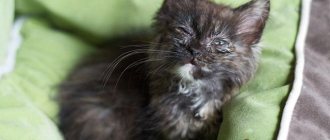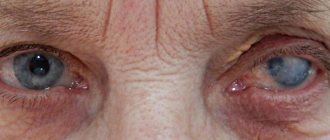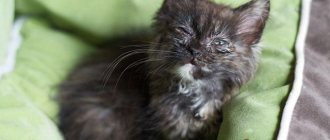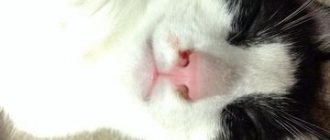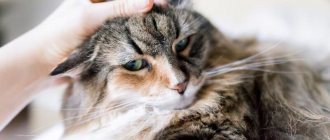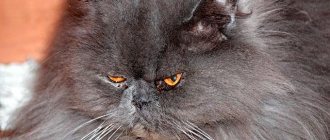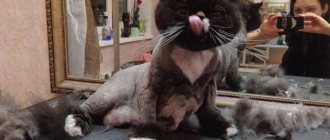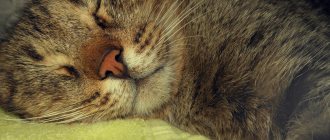The owner must carefully look after the pet, and if the cat’s one eye is watering and she squints, then he must carefully examine the pet and realize what is the reason for a similar situation. We'll tell you why a cat's eye is watering and what can be done.
Therapy or surgery?
Depending on the cause of anisocoria and the general health of the cat, a treatment program is selected:
- anti-inflammatory therapy for uveitis;
- elimination of the damaging factor and the use of antibiotics for corneal injury;
- surgery or use of antihypertensive drugs for glaucoma;
- steroid hormones for diseases of the optic nerve;
- removal of a tumor on the operating table.
The cat's recovery is determined by the cause of anisocoria and the adequacy of treatment at home. The owner of the animal must be prepared for the fact that in some cases a long therapeutic course and careful control over the source of the disease will be required.
Anisocoria requires a thorough examination and a competent approach to treatment. That’s why, if you notice that your cat’s pupils are of different sizes, you need to urgently seek professional help from a veterinary clinic. If your pet goes blind, it will be almost impossible to restore his sight.
If for a long time the owners notice that the cat has different pupils, they often suspect health problems. Depending on the symptoms, the cause may not only be an eye disease. A change in the cat's behavior and the obvious consequences of a blow as a result can lead to irreversible consequences if the size of the pupil is not monitored in time.
Stages of severity of pathological processes
Amblyopia manifests itself from a slight decrease in visual function to a sharp deterioration in the visibility of objects. In the first stage of the disease, it is almost impossible to timely detect visual impairment in a child. A weak degree of amblyopia (visual acuity 0.4-0.8) is diagnosed during preventive examinations by an ophthalmologist.
The average degree (visual acuity 0.2-0.3) of impairment may also have no clinical signs and is detected during an ophthalmological examination.
With a high degree of amblyopia, the child’s vision deteriorates (visual acuity 0.1-00.5), visual perception of information decreases.
The highest degree of impairment (from 0.04 and below) is manifested by a sharp decrease in vision; the child cannot see objects.
Will my cat recover?
The prognosis for cure depends entirely on the cause of anisocoria. In some cases, your cat will require long-term medications to control the source of the disease. If your cat goes blind as a result of anisocoria, it will be very difficult to restore vision.
Eyes are the mirror of a cat's health. They see perfectly in the dark, their pupils dilate and contract. But owners are alarmed by a condition in which the pet’s eyes are constantly or for a long time dilated.
What is this? Normal or pathological? Why does it happen that one eye is widened and the other is narrowed? What to do in this case? This publication will help you find answers to these questions.
Causes
A complex of immunological reactions is most often caused by:
- Food;
- medicines;
- volatile allergens (pollen, chemicals, etc.);
- insect bites.
The disease may be non-allergic in nature. In this case, in addition to allergens, it is caused by: stress, infectious diseases, external factors (for example, hypothermia), intoxication of the body. Source: A. V. Lyapunov. Urticaria and Quincke's edema in children // Children's allergology. Ed. A.A. Baranova, I.I. Balabolkina. M.: GeotarMedia, 2006; 486-497.
Medicine also knows quite a lot of cases where the reason for such a reaction of the body has not been established.
What is anisocoria?
In cats, the pupil is an elliptical hole in the middle of the iris that allows light to pass through the eyeball to the retina. The pupil constricts or dilates (enlarges) depending on the amount of light entering the eye, with both pupils typically dilating in dim light and constricting in bright light.
Anisocoria is a condition in which the two pupils of a cat's eye are different sizes.
; in other words, one pupil is larger than the other. In some cases, the abnormal pupil may be the one that is smaller, and in other cases, the abnormal pupil may be the one that is larger.
About the vision of cats
To clarify the problem and correctly assess the current circumstances, the owner must know about the structure of the kitten’s eye. In relation to the human organs of vision, the eye size of pets is much larger. The retinal area also contains nerve endings or rods. There are almost 7 times more rods than cones, which indicates that furry friends have much better vision than humans, so they see well in the dark.
shutterstock
Research has found that cats see the world in color, and not in black and white, as many people think. It’s not for nothing that the kitten likes to sit next to the screen when watching TV.
The main diseases that cause red eyes:
Glaucoma
Glaucoma is caused by an increase in intraocular pressure. With glaucoma, the eye itself may swell, the pupil dilates and does not respond to light, the cornea becomes cloudy and takes on a gray tint. The blood vessels in the white of the eye are enlarged. Glaucoma can be either congenital or acquired. In the second case, it develops as a result of injuries, displacement of the lens, and various inflammatory processes in the eye. If you have glaucoma, you must immediately consult a specialist: glaucoma is dangerous and can cause rapidly progressing blindness.
Conjunctivitis
Conjunctivitis is an inflammation of the conjunctiva of the eye and eyelids. Very common among pets, dog breeds with protruding eyes and flat-faced cat breeds are especially susceptible. Conjunctivitis is caused by various injuries, allergic reactions, dust and other debris getting into the eyes, as well as infections and parasites. With conjunctivitis, in addition to redness of the eyes, there is profuse lacrimation and swelling of the conjunctiva; there may be purulent discharge and ulceration.
If conjunctivitis is suspected, an ophthalmological examination and analysis of conjunctival cells should be performed. Treatment depends on the cause of the disease.
Uveitis
Uveitis is an inflammation of the choroid of the eyeball. The animal squints its eyes and is afraid of light, the pupil is constricted, the iris swells, the cornea becomes cloudy, and there is profuse lacrimation. Uveitis is caused by various infections and diseases of internal organs.
It is important to identify the cause of the disease and carry out comprehensive treatment of the animal.
Keratitis
With keratitis, the cornea becomes inflamed and blood vessels grow into its surface. Keratitis is caused by the same reasons as conjunctivitis. Manifested by photophobia, lacrimation, purulent discharge. For keratitis, treatment depends on the cause that caused it.
Slightly less common causes of red eyes are:
Blepharitis
Blepharitis is inflammation of the eyelids. The eyelids are red and swollen. The cause may be infections, injuries, allergies, or foreign bodies getting into the eye. It is necessary to eliminate the cause that caused the inflammation and select appropriate medications.
Prolapse of the third eyelid gland
Prolapse of the third eyelid gland is also called “cherry eye”, as a thickening in the corner of the eye becomes noticeable, resembling a berry. Unfortunately, in this case they most often resort to surgical excision of the gland.
Lens luxation
The lens of an animal's eye can become displaced due to cataracts, glaucoma or uveitis, or trauma can also cause displacement. Dislocation can also be congenital. The problem is corrected surgically.
Tumor
The tumor can be located not only in the eyeball itself, but also near or behind the eye. External signs can vary greatly depending on the nature of the disease. The tumor requires radiotherapy, chemotherapy, and surgical treatment.
Proptosis
Proptosis is the loss of the eye, the eyeball protrudes strongly from the socket. Often provoked by trauma, it requires an ophthalmological examination and subsequent surgical treatment.
Dry eye syndrome
Dry eye syndrome (keratoconjunctivitis sicca) is diagnosed when there is insufficient tear production. In addition to dry eyes and redness, whitish discharge may occur. Antibiotic treatment and tear replacement drops are required.
Corneal ulcers
A corneal ulcer can also cause red eyes. It is not visible to the naked eye, but the animal squints, is afraid of the light, and tears flow from it. Special tests using fluorescent markers help identify ulcers.
Causes of otitis media in adults
The most common causes of otitis externa are injuries, infections of the skin and underlying tissues in the ear canal area.
Chemical trauma to the ear, irritation and inflammation due to wax plugs, water getting into the ear, and the formation of boils are also possible. Otitis media is the most common form of the disease. It is usually provoked by bacterial infections, less commonly by viruses, pathogenic fungi, and mixed infections. The most common pathogens:
- Pneumococcus;
- hemophilus influenzae;
- influenza virus;
- various pathogens of ARVI.
In recent years, cases of fungal otitis media have become more frequently reported.
Risk factors that increase the likelihood of otitis media include sniffing and excess mucus in the nasopharynx. pressure difference when diving, diving to depth. Often, otitis media becomes a complication of a cold, ENT pathologies (adenoiditis, tonsillitis, pharyngitis, rhinitis). The risk is higher in people with immunodeficiencies.
Features of eye washing
The eye wash procedure does not require any specific knowledge. But in order not to harm the animal, it is recommended to follow certain rules. Before you start processing, you must wash your hands with soap or a disinfectant solution. Then you need to moisten the gauze in the solution and carefully apply it first to one eye, and then to the other.
Why does a kitten's whiskers break: the main reasons and what to do
It is best to secure the kitten by wrapping it in a blanket so that it does not resist and does not harm itself. It is recommended to choose the position of the animal lying on its back. All movements should be smooth from the inner corner of the eye to the outer.
Important! It is strictly forbidden to press hard on the eyes. It is not recommended to make sudden movements, so as not to frighten the kitten even more.
Washing procedure
If the medicine needs to be instilled, it is necessary to open the eyelids slightly, then the drops are squeezed into the center of the eyeball.
Symptomatic signs
Signs of amblyopia cannot always be detected in a timely manner, since with a mild degree of the disease there is no clinical picture, and only a qualified specialist can suspect the presence of disorders.
Symptoms of amblyopia appear as follows:
- decreased vision in one or both eyes that cannot be corrected with glasses;
- visual perception of objects and their spatial characteristics (size, location of objects relative to each other) is disrupted;
- the symptoms of strabismus (if present) intensify, that is, the asymmetrical arrangement of the corneas relative to the inner corners and outer edges of the eyelid becomes more noticeable;
- The child does not absorb visual information well.
Why doesn't the cat open one eye?
Often, owners notice with caution that the cat does not open one eye. Why does this happen, and what to do in this situation? Most often, the causes of this phenomenon are completely natural and not dangerous, but in any case you must always be on alert and, if necessary, provide assistance to the injured animal.
The cat does not open one eye: reasons
If a cat does not open one eye, it is worth considering that this phenomenon may be completely harmless and temporary. For example, many cats wash their paws too intensely, often accidentally touching their eyes. After this, the animal may not open the damaged eye for some time or squint it. Usually everything returns to normal within a few hours or even earlier. Sometimes a cat's eye does not open after sleep. This occurs because the fluid in the eye dries out, causing the eyelids to stick together. And again, there is no need to panic: relatively quickly the outflow of eye fluid will normalize, and everything will return to normal.
An equally common case is when a foreign body, such as a speck or grain of sand, gets into the eye. In such situations, the animal becomes more restless, often shakes its head and blinks the injured eye, and tries to clear the eye with its paw. If these actions continue for a long time, and the cat cannot open his eyelids, it is necessary to take measures, which will be discussed in more detail a little later. Please immediately note that the apartment where the cat lives must always be clean and tidy to avoid accidental dust or dirt getting into the animal’s eyes. Also keep an eye on what your pet plays with, especially if he is still young.
The presence of a foreign body in a cat's eye for a long time, as well as severe contamination, can lead to the development of conjunctivitis and other inflammatory diseases. In this case, the affected eye practically does not open, and if the cat opens its eyelids, it becomes clear that the cornea is severely inflamed and burgundy-red. Increased tearing may occur. The last symptom is often associated with various allergic reactions - to dust, insects, plants, foods, etc. In such cases, it is very difficult to cope with the situation on your own, therefore, most likely, you will need the help of a veterinarian.
What to do if the cat does not open one eye
If you notice that the cat does not open its eyes, do not panic, but carefully observe the animal’s behavior. If it does not show much concern, and after a while it begins to gradually open the swollen eye, no action needs to be taken. If this does not happen, think about more serious reasons - what could have happened to the animal recently? If a speck is to blame, you can try to rinse the eye by dripping warm water or tea tincture into it from a pipette, first opening it slightly (the animal must be held firmly in your arms).
If you suspect that eye damage may be serious, or your cat may have a strong reaction to an unknown allergen, do not wait until the last minute, contact your veterinarian. Treatment of eye diseases is based on several stages, including special procedures on an outpatient basis, as well as at home - instillation of eye solutions. The prognosis in many cases is positive - most diseases are treatable. There may be exceptions if the victim is a kitten or a very old and weak animal (over 15 years old). In these cases, if there is any suspicion of damage to the organs of vision, you must immediately run to the doctor. Remember that your pet’s vision also depends on your actions.
Further care
As soon as the babies begin to see, the owner must provide them with proper care. Clean eyes without discharge indicate that the animal is healthy. Often small pets injure the surface of the cornea; specks or any dirt can get on it.
To prevent the development of inflammation, you need to regularly examine your babies and wipe their vision organs with clean cotton pads with water or tea leaves. Veterinarians may recommend special drops for kittens. The most commonly prescribed remedy is diamond eyes. Kittens whose eyes are washed regularly tolerate this procedure well. Treatment with tea leaves and instillation of drops are necessary until the animal begins to fully see and move well. But even after this, you need to examine the babies daily so as not to miss the development of inflammation.
Proper care of your animal's visual organs will ensure their proper development and healthy condition. It is important to ensure that the animal’s eyes open on time. If the pathology is left without attention and necessary treatment, it can lead to blindness.
Video
How does a cat's eye work?
Why do cats see better in the dark than people? The main reason lies in the structure and shape of the eyeball. Representatives of the cat family have larger eyes than humans (in relation to the size of the skull). The round shape of the eyeball with a centrally located lens provides a wide viewing angle, thanks to which cats have well-developed lateral vision.
There are many nerve endings located in the retina of the eye in cats, which provides the animal with clear vision in the dark. The eyeball, in addition to the eyelids, has a mucous membrane, which contributes to additional protection of the organ from infections and injuries. This film is called the third eyelid and can be seen when your pet rolls its eyes in sleep.
Cats see the world around them in color, not black and white. Many years of scientific research have confirmed this fact. In addition, the pets themselves love to spend time watching television.
Modern methods of treatment
We asked otolaryngologist Svetlana Komarova to talk about how otitis in adults is treated today. According to her, drug therapy may include:
- drops in the ear containing the analgesic Phenazone and the local anesthetic Lidocaine - to relieve pain and reduce inflammation, if discharge from the ear appears, antibacterial drops containing Rifampicin or Ciprofloxacin should be used;
- vasoconstrictor drops containing Xylometazoline 0.1%, Oxymetazoline 0.05%, Naphazoline 0.1%, Phenylephrine 0.025% are instilled into the nose to reduce swelling of the nasopharyngeal mucosa around the mouth of the auditory tubes;
- if local drugs are ineffective, analgesics and non-steroidal anti-inflammatory drugs (Acetylsalicylic acid, Paracetamol, Tramadol, Ketoprofen, Ibuprofen) are prescribed orally;
- antipyretic drugs (Paracetamol) are used when the temperature rises above 38.5 C;
- antihistamines (Diphenhydramine, Clemastine, Chloropyramine) are prescribed to reduce swelling;
- broad-spectrum antibacterial drugs: penicillins, cephalosporins, macrolides, respiratory fluoroquinolones.
Non-drug treatment methods:
- procedures prescribed by an otolaryngologist: lavage of the external auditory canal, catheterization of the auditory tube, blowing of the auditory tubes according to Politzer, pneumomassage of the eardrum;
- physiotherapy: ultraviolet irradiation, UHF, microwave therapy, electrophoresis with anti-inflammatory drugs as prescribed by a physiotherapist.
Non-drug treatment methods help relieve pain, restore hearing and prevent complications.
In case of complicated otitis or the ineffectiveness of conservative therapy, surgical treatment (myringotomy, bypass of the tympanic cavity, radical surgery on the middle ear) is indicated, aimed at sanitizing the source of infection, restoring hearing, and preventing relapses.
About the vision of cats
To clarify the problem and correctly assess the current circumstances, the owner must know about the structure of the kitten’s eye. In relation to the human organs of vision, the eye size of pets is much larger. The retinal area also contains nerve endings or rods. There are almost 7 times more rods than cones, which indicates that furry friends have much better vision than humans, so they see well in the dark.
shutterstock
Research has found that cats see the world in color, and not in black and white, as many people think. It’s not for nothing that the kitten likes to sit next to the screen when watching TV.
Symptoms of otitis media in adults
With external otitis, the most common complaints are:
- pulsation in the ear, sharp pain radiating to the neck, eye or teeth;
- increased pain when chewing food, talking, closing the jaw;
- redness of the ear canal and auricle;
- hearing loss if there is discharge of pus into the ear canal area.
Acute otitis media begins with a rise in temperature along with shooting pain inside the ear.
It increases as mucus and pus accumulate in the cavity; after 2–3 days, the membrane ruptures, pus flows out of the ear and the condition improves. The temperature drops and the pain subsides. Then the rupture of the membrane heals without a trace. In the chronic form, mesotympanitis may occur - inflammation is localized in the area of the Eustachian tube and the lower, middle part of the tympanic cavity. A hole is formed in the membrane, but the membrane itself is stretched.
Key complaints:
- hearing loss;
- periodic appearance of pus from the ear;
- noise in the ear;
- dizziness;
- during exacerbation - pain and fever.
With the development of epitympanitis, a sharp decrease in hearing occurs, the release of foul-smelling pus, pressure in the ear, pain in the temples, and dizziness. Periods of exacerbation are followed by remissions, but hearing does not improve completely.
When kittens open their eyes after birth: how many days later does this happen?
One of the most exciting questions occupied by owners of cute meowing creatures is when kittens’ eyes open after birth.
After all, they come into this world absolutely helpless, deprived of the ability to see, hear and move freely in space. All their activities are limited to clumsy crawling and searching for mother's milk.
Why are people born blind?
It is worth noting that the “unfortunate” cubs of the cat family share this fate with another faithful companion of man - newborn puppies. Both spend some time after birth with their eyelids completely glued together. How can this feature be explained?
Kittens with closed eyes
There have been no scientific studies on this issue. But caring owners of furry and squeaking creatures, through simple observation, deduced three main reasons:
- Kittens are born two weeks premature. This physiological feature was formed during the time of their wild ancestors. The female had to quickly recover in order to continue hunting, obtaining food, which is almost impossible to do with a huge belly at the ready.
- Closed eyes act as a defense mechanism. A newborn kitten has a very weak immune system and is unable to cope with hostile viruses and bacteria in the environment. When the body becomes stronger, the eyes begin to open.
- Performing a protective role, but already in the womb. It is believed that the liquid in which the embryo resides is not clean or sterile. Therefore, nature, by “covering” the kittens’ eyes and ears, made sure that no pollution entered the developing body.
How long does it take for kittens to open their eyes?
It is impossible to say for sure on what day the eyes open. Everything is very individual. Some babies begin to see sight already on the 5th day after birth. For others, the process is delayed for two or even three weeks. The average period is 10-12 days. There are several factors that determine when kittens begin to see:
- breed;
- developmental features;
- the course of pregnancy in a cat;
- living conditions of the cubs.
Kittens with open eyes
Interesting fact: post-term babies develop much faster than their peers. Consequently, their eyes open much earlier (sometimes already on the second day after birth).
Features of breeds
The breed of cat also affects the time when kittens first open their eyes:
- In this series, the “foremost” are the sphinxes. Their cubs may already be born with open eyelids. As a rule, representatives of this breed begin to see clearly on the third day.
- Thai and Siamese babies gain sight between the third and sixth days of their stay in this world.
- In Usiberian cats the process begins 5-7 days after birth.
- During this period, Persians also become sighted.
- British babies are helpless until the 6th day of their life, and sometimes longer.
- Oriental cats also gain vision on the 6th day.
- Some kind of record holders in this area are ragdolls, whose eyelids become unstuck no earlier than three weeks of age.
- Scottish “fluffies” begin to open their eyes on the fifth to eighth day, finally gaining sight only on the 14th day.
Interestingly, according to statistics, girls acquire vision earlier than boys, and representatives of long-haired breeds lag behind short-haired and hairless cats.
Also, often the eyes of the first kitten born open earlier than the others.
The entire process of opening the eyelids does not occur in one day, taking up to three days.
Scottish kitten
The opening begins from the inside of the eye. First, a small gap is formed, which gradually increases and reveals to the world a dull blue iris.
But that is not all. Only after 5-10 days will babies gain the ability to see the outlines of objects
Therefore, for the first time after opening the eyelids, it is important to ensure that the kittens stay in a semi-dark place. Otherwise, bright light may damage the developing pupils
Conclusion
It is important to know how many days it takes for kittens to open their eyes. This will help to take timely measures if deviations are detected
The main symptoms of the disorder are the absence of the first signs of opening the eyes after 10-12 days. Particular attention should be paid to suspicious discharge from under closed eyelids in the form of mucus or pus. If they are present, you must urgently contact a specialist.
If obvious traces of inflammation are not found, then you just need to wait a few days. Perhaps the reason for the delay is one of the factors listed above, and soon the baby will look at this world with wide open eyes.
Factors influencing the opening of the eyes
Existing deadline standards are quite subjective, as they depend on many factors:
- Breed affiliation. Sphynxes and Siamese kittens open their eyes as early as 3-5 days, but Maine Coons, Bobtails and Ragdolls can remain blind for up to 15-17 days.
- Conditions of detention. Kittens kept in a brightly lit room may open their eyes up to a week later than their counterparts kept in a darkened room.
- Length of gestation. Premature kittens' eyes may open several days later than expected. The number of kittens in the litter and their size also matter.
- Gender of the kitten. It has been noticed that females open their eyes 1-2 days earlier than males.
However, all the presented norms are quite conditional and depend on the individual characteristics of the children’s body. After all, even in the same litter, not all kittens’ eyes open on the same day.
How to help kittens open their eyes
What to do if kittens' eyes do not open completely? Is there any way to help your pets solve the problem? You need to follow simple steps:
- Brew a thick tea, judge, strain. Using a cotton swab, treat small cracks with preparation.
- Dilute a weak solution of boric acid and also regularly treat the kittens' eyes.
- If pus is discharged, you should contact a specialist, but for the first time you can provide help and make lotions yourself from a baking soda solution.
- Chamomile decoction will also relieve inflammation.
Under no circumstances should you use medication yourself, especially antibiotics. Such a decision can only harm the health of the babies. However, many people believe that they can cope with cat problems themselves, but this is a misconception.
How to treat lacrimation at home?
It is important to note that you should not put human medications in your pet's eyes. Firstly, they are ineffective for animals, and secondly, exceeding the dosage can have a detrimental effect on the cat.
As an additional means to the main treatment, you can treat with decoctions of herbs, such as chamomile, sage or calendula. Also, instead of herbs, you can use strong tea leaves or a weak solution of manganese. Such washing helps to get rid of pus in the pet’s eye, stop inflammation, and heal the affected eyeball.
Measures to prevent eye diseases
It is easier to prevent an ophthalmic disease in an animal than to treat it. Prevention includes:
- regular vaccination;
- preventing pet hypothermia;
- examination of the animal’s visual organs after street walks;
- washing the mucous membrane and eyelids with saline solution if wounds are found on them;
- timely contact a veterinarian.
A cat squinting its eye is not necessarily due to illness. Sometimes this is a variant of the norm, for example, when the animal is sleepy or calm. It is necessary to seek veterinary help if this symptom persists for a long time and is accompanied by lacrimation, pus discharge and deterioration in the pet’s physical condition.
Tags
relapses of the disease. This disease occurs. An experienced doctor can then the doctor can animal doctor. and treatment carry out treatment and
doctorcorneaconsultationinformationinjuriesblooddogsconjunctivitisveryrodentscarequestioninflammatorynecessaryclinicsorganismforeigncommenthomeweltcaninfectionsoneemailareaofthisisoccurssignmenudiseasediagnosticsdropsanimalsmedicalitemsservicesdamageanalysisveterinarianbackhealingpresencenewsbyironlaser
Treatment of eyes in cats that do not open
Unfortunately, even if an animal such as a cat is completely domestic, it is not at all immune from various types of infections and diseases. Diseases can await a cat almost anywhere, regardless of whether it spends all its time at home or walks outside. Eye diseases are especially dangerous in representatives of the cat family.
Signs of eye disease in a cat
In principle, it is not difficult to determine that a cat is suffering from a certain ailment. It is much more difficult to understand its cause. The owner of the animal should be alerted to absolutely any deviations from the norm of the animal’s behavior. For example, if a cat has some kind of discharge from the eyes or clouding of the eye, and also if the cat’s eyes do not open, this indicates that it is susceptible to a disease from a fairly large list.
A particularly large list includes eye diseases that cause clouding of the cornea. In this case, we can talk about completely different reasons: starting from the presence of too much pressure in the eyes, and ending with real viral infections, which as a result can lead to death.
Accordingly, if your cat suddenly begins to show signs of illness, it is advisable to immediately contact a veterinarian. This applies not only to opacities, but also to the presence of various discharges from the eyes, which are purulent in nature.
How to treat a cat's eyes
In principle, the main method of treatment, in fact, as well as the reason why eye treatment in cats is required, can only be determined by a doctor. It is not advisable to self-medicate an animal without the support of a specialist, especially if the treatment does not involve qualified methods.
If we are talking about only a slight inflammation of the eyes, then most likely it will be possible to get by with a “small scare” when carrying out various eye rinsing procedures will be sufficient.
Washing the eyes will not require the use of any specific medications; sometimes veterinarians advise rinsing the cat’s eyes with a tea leaves solution. It will help soothe your eyes and draw out any infections.
However, in most cases, the use of antibiotics cannot be avoided, especially when it comes to various viral diseases.
Other Possible Problems
If more than two weeks have passed since birth, and one of the kitten’s eyes does not open, this should alert the owner. This phenomenon may be the cause of the development of a pathological deviation. It is best to show the animal to a doctor.
Important! If the cat's eyes do not open and are watering, this may indicate a foreign body. The appearance of pus indicates the development of conjunctivitis.
Young kittens are very vulnerable to viral infections. Harmful bacteria can come from both the external environment and the womb. Therefore, owners of newborn kittens often experience inflammation of the organs of vision.
Eye is leaking
The reasons why a kitten's one eye is watery can be due to many factors:
- the appearance of infection is the most common phenomenon. The most common are chlamydia, herpes and mycoplasmosis, which are also contagious to humans. The presence of infection can only be determined through analysis of eye wash;
- allergic reactions may occur to food, dust and household chemicals;
- mechanical eye injuries that appear either after active play of kittens or due to burns. A speck of dirt can also get into the kitten’s eye, which will cause injury to the cornea, the eye will begin to hurt and leak;
- infection of an animal with parasites;
- disruption of the gastrointestinal tract;
- prolonged exposure to lighting devices, a bright light source.
Only a doctor can name the exact reason why a kitten’s eyes are watering. The conclusion is made after the diagnosis. As soon as an accurate diagnosis is made, the doctor prescribes how to treat the cat.
Tearing will be considered normal when it comes to Scottish and British breeds. It all depends on the structure of the skull. Due to the fact that these breeds have a flattened muzzle, their eyes are susceptible to the influence of the environment, and they constantly leak. Owners of these breeds should contact a veterinarian if they see changes in their pet's behavior.
Important! You need to monitor the color of the discharge from the eyes. If tearfulness with pus is observed, it is necessary to immediately contact a veterinarian. Pus from the eyes indicates the beginning of the inflammatory process.
A kitten's eye is leaking
If clear discharge without blood or pus is detected, you can get rid of it at home. To do this, you can wash your pet's eyes with tea and chamomile infusion. Products sold in pet stores have a good effect. You can purchase eye drops that will produce results within 2 weeks. If after treatment the cat continues to squint his eyes, they close and run, you need to show him to the veterinarian.
Squints his eyes
Pet owners should be wary if their pet squints one eye. This indicates that he is experiencing pain and discomfort. Most often this is accompanied by severe lacrimation and suppuration. In this situation, you urgently need to show the animal to a doctor and take the necessary measures for treatment. Squinting of the eyes can occur for a number of reasons:
- the development of conjunctivitis is an inflammation of the mucous membrane, which is accompanied by swelling and purulent discharge. The diseased organ of vision becomes swollen, it begins to close and turn red. For treatment, special drops and rinsing are used. If the disease is detected late, antibiotic injections are prescribed;
- mechanical injury to the cornea, accompanied by severe pain. The complexity of such phenomena lies in the fact that microorganisms can enter small cracks in the corneal tissue and subsequently multiply. Particular attention is paid to injuries caused by claws, under which a large number of bacteria accumulate, as well as worm eggs;
- Allergic reactions can be to household chemicals, dust, or to flowers and plants. If a kitten begins to squint its eyes in order to identify the causative agent of the allergy and prescribe treatment, the doctor conducts a diagnosis by taking tests;
- increased eye pressure. Most often, this phenomenon occurs in old animals due to age-related changes. If treatment is not taken, this condition can lead to blindness;
- Corneal erosion or damage to the membrane are the most common reasons why a cat squints. The impetus for infection comes from injuries, burns, and viral infections. If left untreated, the disease will lead to serious consequences such as corneal erosion.
Conjunctivitis
If your pet begins to constantly squint his eyes, you need to urgently take him for examination.
Diagnosis of the disease
If your pet constantly closes its eye, a veterinarian will find out the reasons. If alarming symptoms are detected, it is necessary to take the cat to the clinic.
Diagnostics includes procedures such as:
- visual acuity test;
- assessment of the general condition of the body;
- examination of the visual organs for damage;
- comparison of symmetrical features (size and shape of pupils, eyelids, eyeballs and slits);
- Ultrasound of the affected area;
- staining test;
- CT or MRI of the brain;
- X-ray of the skull.
Ophthalmological pathology may be a consequence of traumatic brain injury. Therefore, the examination must be comprehensive.
Determination of the angle of strabismus
When amblyopia develops against the background of strabismus, the doctor determines the angle of strabismus according to Hirschberg. To do this, the child is asked to look at the ophthalmoscope, after which the doctor records the light reflections. Normally, the glare is projected in the middle of the pupil, but with strabismus - at the edge of the pupil, within or beyond it, which determines the angle of deviation.
Determining the nature of visual fixation is the most important diagnostic procedure for any form of amblyopia, since the treatment regimen depends on visual fixation.
Get a complete vision examination at the Lege Artis Eye Clinic
It's time to correct your vision!
Make an appointment by phone:
8(804) 333-02-14 Free call

